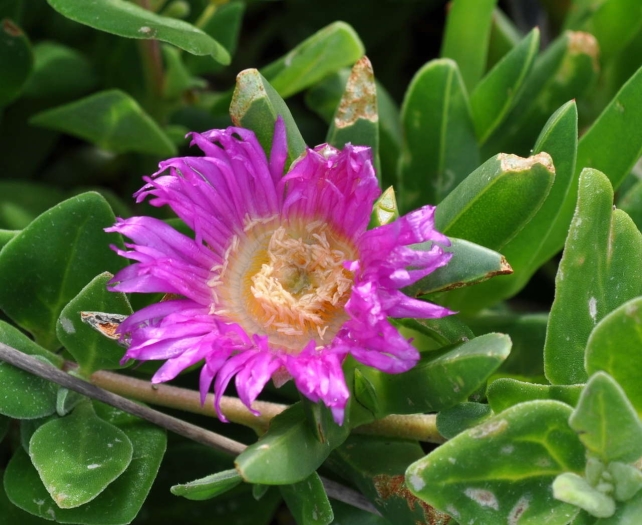Karkalla
(Carpobrotus rossii)
Karkalla (Carpobrotus rossii)
/
/

© Kevin Sparrow
CC BY 4.0
Image By:
© Kevin Sparrow
Recorded By:
Copyright:
CC BY 4.0
Copyright Notice:
Photo by: © Kevin Sparrow | License Type: CC BY 4.0 | License URL: http://creativecommons.org/licenses/by/4.0/ | Uploader: banksiaman | Publisher: iNaturalist |

























Estimated Native Range
Summary
Carpobrotus rossii, commonly known as karkalla or pigface, is a succulent perennial groundcover native to coastal dunes and cliffs of southern Australia. It typically forms dense mats with fleshy, triangular leaves and spreads vigorously across the ground. Karkalla blooms from spring to summer, producing showy, daisy-like light purple to pink flowers that attract pollinators. The plant can reach a height of 4-6 inches (10-15 cm) with an indefinite spread due to its creeping habit.
Karkalla is valued for its drought tolerance and ability to stabilize sandy soils, making it an excellent choice for coastal and xeriscape gardens. It thrives in full sun and requires well-drained soil, tolerating poor, sandy substrates. In cultivation, it is used for ground cover, rock gardens, and as an ornamental feature in succulent plantings. It is also known for its edible fruit, which is enjoyed by local wildlife and can be used in jams and desserts. However, gardeners should be cautious as Carpobrotus rossii can become invasive outside its native range, particularly in similar coastal environments. It is generally pest-free but can suffer from fungal diseases in poorly drained soils.CC BY-SA 4.0
Karkalla is valued for its drought tolerance and ability to stabilize sandy soils, making it an excellent choice for coastal and xeriscape gardens. It thrives in full sun and requires well-drained soil, tolerating poor, sandy substrates. In cultivation, it is used for ground cover, rock gardens, and as an ornamental feature in succulent plantings. It is also known for its edible fruit, which is enjoyed by local wildlife and can be used in jams and desserts. However, gardeners should be cautious as Carpobrotus rossii can become invasive outside its native range, particularly in similar coastal environments. It is generally pest-free but can suffer from fungal diseases in poorly drained soils.CC BY-SA 4.0
Plant Description
- Plant Type: Succulent
- Height: 0.2-0.5 feet
- Width: 3-6 feet
- Growth Rate: Moderate
- Flower Color: Pink
- Flowering Season: Summer
- Leaf Retention: Evergreen
Growth Requirements
- Sun: Full Sun, Part Shade
- Water: Low
- Drainage: Fast
Common Uses
Bee Garden, Bird Garden, Drought Tolerant, Edible*Disclaimer: Easyscape's listed plant edibility is for informational use. Always verify the safety and proper identification of any plant before consumption., Fire Resistant, Groundcover, Low Maintenance, Salt Tolerant, Showy Flowers, Street Planting
Natural Habitat
Coastal dunes and cliffs of southern Australia
Other Names
Common Names: Karkalla, Beach Banana, Pig Face
Scientific Names: , Carpobrotus rossii, Mesembryanthemum rossii,
GBIF Accepted Name: